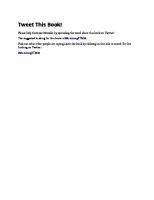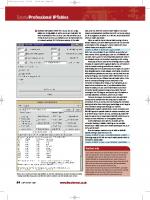Mastering IPTables
466 100 428KB
English Pages 6
Recommend Papers
File loading please wait...
Citation preview
LXF14.pro_tutip
4/4/01
10:34 am
Page 82
TutorialProfessional IPTables INTERNET SECURITY
Mastering IPTables Security chief David Coulson shows you how 2.4's new Iptables features can be used to keep out unwanted crackers. hen Linux 2.4 was released, most people focused on what it would do to help the average Linux user and talked about the USB support, firewire, PCMCIA and DRI. While these are great additions to the kernel for the majority of people, often one of the major improvements over 2.2 was overlooked, even though it applies almost as much to Joe (and of course Jane) User as it does to a hardened network engineer. This is, of course, the inclusion of the ‘netfilter’ system into the kernel, which provides packet filtering
W
different, it’s worth understanding exactly what each of them do and how we should view the organisation of the firewalling code in the kernel. Netfilter is the system compiled into the kernel which provides hooks into the IP stack which loadable modules (iptables is one) can use to perform operations on packets. As netfilter uses modules for the filtering, you can use an ipchains module to provide exactly the same capabilities as the kernel level ipchains code in 2.2, or even the module for ipfwadm from 2.0. Netfilter is there all of the time, as long as it is compiled in, whether or not you are using any firewalling modules at all. IPTables is split into two parts; The user-space tools and the kernel-space modules. The kernel-space modules are distributed with the main kernel, and you compile them as you would any other module, be it sound drivers, a filesystem or USB support. There is the main ip_tables module, as well as modules specifically for NAT, logging, connection tracking and so on. These modules perform the appropriate function on the packets which they get sent by netfilter, depending on the rules which they have in their rule-list, or chain. The user-space iptables code comes in the form of a binary called ‘iptables’, which is distributed separately from the main kernel tree, and is used to add, remove or edit rules for the modules. This is comparable to the ipchains binary in 2.2. Often, when referring to iptables, it is assumed to mean the iptables binary, and we will continue to use such a standard here.
Configure, compile, install, reboot Conntrack means you can find out which connection specific packets are associated with.
and other more advanced IP features. Along with ‘netfilter’ comes ‘iptables’, which is the 2.4 equivalent of ipchains, and provides a user-space interface to the filtering, Network Address Translation (NAT) and mangling modules. We’re going to look at building 2.4 with support for netfilter and iptables, then building a production level router out of it. For those of you who just have one machine, and use it to connect to the Internet, then many of the same rules apply. The Internet is one giant, generally unrestricted, network which any reasonable person would have reservations about putting any sort of machine on, never mind their own Linux system.
Netfilter or iptables? Often when referring to the firewalling code in 2.4, it will blindly be referred to as ‘netfilter’ or ‘iptables’, without any justification for using the specific name for it and, given that they are both very
82
LXF14 MAY 2001
Ideally, you need to have a machine which is already running a 2.4 kernel, or have the knowledge to install 2.4 on a machine currently running 2.2., as the required updates to make sure 2.4 runs without problems are outside the scope of this article. This machine is going to be for mission critical routing, so the use of the latest bleeding edge kernel is not really necessary; all we need is something which is stable, secure and is not going to corrupt our filesystems. Aside from all of the other options which you may or may not need, there are numerous settings under ‘Networking Options’ which don’t directly pertain to iptables, but are applicable to many features of it. Firstly, we need to select ‘Network Packet Filtering’, which basically enables the use of netfilter, although unless you’re intending to become a netfilter developer, you won’t need the debugging option. You will probably also want to enable ‘IP: advances router’ and ‘IP: use netfilter MARK value as routing key’. We next need to compile
www.linuxformat.co.uk
LXF14.pro_tutip
4/4/01
10:34 am
Page 83
Professional IPTablesTutorial
A packet’s journey through the filters
PREROUTING D-NAT
POSTROUTING S-NAT
ROUTING DECISION
OUTPUT D-NAT OUTPUT D-NAT
some modules which netfilter can use, with the ‘IP: Netfilter Configuration’ sub-menu. Everything there needs to be selected as m, apart from the 2.2 and 2.0 support, unless you specifically need to use ipchains or ipfwadm on the machine while you learn to use iptables. As with any kernel rebuild, make dep && make clean && make bzlilo && make modules && make modules_install, then reboot, assuming you are using lilo.
IPTables Once the new kernel is up and running happily, we can go ahead and compile the userspace iptables tool. You can download this, the latest release being 1.2, from http://netfilter.kernelnotes.org/. It is basically a matter of doing make; make install, as root, and everything is sorted out. You will need a configured 2.4 kernel available for iptables to compile against, so if you’ve not yet built 2.4, or have deleted the source code, you might want to take a few steps back and have another go. Next we need to load the ip_tables module into the kernel using modprobe ip_tables. A lot of the other modules are loaded automatically as we use the various features, but both ip_nat_ftp and ip_conntrack_ftp need to be loaded manually, and we will look at their usage later.
Filtering As with ipchains, iptables has three lists of rules – or chains – for filtering. For those of you who are confused about moving from ipchains, they have exactly the same names, but have to be in upper case, so there is INPUT, OUTPUT and FORWARD. INPUT applies to all packets destined for the local machine, OUTPUT for packets which originated locally and FORWARD for packets which are sent to our machine, but are not actually for it. We can, if we choose, create our own chains to organise our
rules into different groups based on other rules. We create a rule with iptables -N and delete it with iptables -X . After this, they behave just like the three default chains, and we can flush them with iptables -F or list their rules with iptables -nL . Using iptables we can perform three actions on the chains which alter their rules. We can either add, insert or delete rules, using -A, -I and -D, respectively, followed by the chain name. So, if we wanted to add another rule to the end of the INPUT chain we would use iptables -A INPUT. Not much use so far, as we need to specify which packets we want the rule to apply to. Matching source and destination IPs and ports is the most straight forward things to do. If, for example, we want to block all connections to port 23, over tcp, to a local machine we would do: iptables -A INPUT -p tcp --dport 23 -j DROP -p sets the IP protocol used, be it TCP, ICMP, UDP or one of the other more unused protocols, and --dport specifies the destination port of the packet. We can, of course, use --sport to specify a source port, but that is rarely used as connections usually use a random source port, unless they are from a specific service, such as NTP or BIND which has packets coming from a specific port. Those who migrated from ipchains will be familiar with the difference between DENY and REJECT. However, the people who wrote iptables thought that DENY and REJECT sounded like the same thing, so there is now DROP and DENY. DROP literally drops the packet without making any effort to clean up afterwards, whereas DENY drops the packet, then returns an ICMP packet to the source of the packet to tell it that the connection was denied. Describing source and destination IP addresses is often used to distinguish between trusted and unknown networks, and there are a number of different ways to refer to IPs and network
www.linuxformat.co.uk
When a packet reaches a junction, it is examined to see if any action should be taken or if it should move onto the next chain.
>> LXF14 MAY 2001
83
LXF14.pro_tutip
4/4/01
10:34 am
Page 84
TutorialProfessional IPTables with iptables. Within the rule, we can use -s > LXF14 MAY 2001
85
LXF14.pro_tutip
4/4/01
10:34 am
Page 86
TutorialProfessional IPTables
You will need to enable the new features of the kernel before you use them!
86
/proc/sys/net/ipv4/ip_forward Notice that we don’t need any ugly rules for active FTP, as we use ip_conntrack_ftp, which stops the incoming FTP connections being tracked as NEW. We might want to allow some ports, such as 113 and 25, for identd and SMTP mail delivery. We just do: iptables -I INPUT 1 -p tcp -m multiport --dport 113,25 -j ACCEPT multiport is a matching option which can be used to specify multiple ports within the same rule, either --dport or --sport. To have this happen every time we reboot, we can use a combination of iptables-save and iptables-restore to save and restore the rules, or we can just write a bash script, or pop it on the end of /etc/rc.d/rc.local, depending on the distribution. Usually, if you’re just starting out, it is best to use a script, as you can change it, rerun it, and you can be 100% sure that if you reboot the machine, it will end up how you have it now. However, this isn’t much use if you’ve got a couple of hundred machines behind a firewall and want to run proper web and mail servers, and allow internal machines to access the outside world transparently. The simplest way to do this is to setup a selection of 10.1.x.0/24 networks, and put different classes of machines on them, such as front end servers, back end servers and workstations, as we will want to apply rules to each class in order to secure the network. The actual internal structure of the network depends on the services used, but it is not best to plug backend servers onto a hub along with a load of web servers. The public IPs will all be allocated to the public interface on the router, so the internal machines need not care which IP they are using, let alone how anyone gets to them. Firstly, we need to take control of the IPs we are going to use, which is nothing more than making sure the public side of the LAN, which will probably consist of little more than a router for the line, knows where to send packets destined for the IPs we have. The quickest way is to setup IP Aliases for the network interface which faces the outside world, eth0 in our case, so we might have ‘eth0:mail’ as the interface for the mail server’s IP. We could, instead, use arp to publish the NICs MAC addresses relationship to the IP with arp -Ds 192.168.1.2 eth0 pub, where 192.168.1.2 is the public IP. Which ever method is chosen, it will have to be performed whenever the machine is rebooted, so it should be inserted within the iptables setup script. We will want all packets going to 192.168.1.2 to head for our mail server 10.11 . .2, and anything coming from 10.11 . .2, that is new connections, to look as if they are from 192.168.1.2: iptables -t nat -A PREROUTING -p tcp -i eth0 -d 192.168.1.2 -dport 25 -j DNAT --to 10.1.1.2:25 iptables -t nat -A POSTROUTING -s 10.1.1.2 -o eth0 -j SNAT -to 192.168.1.2 All packets coming from our workstation network should only come out of one IP, which is easily done with another SNAT rule: iptables -t nat -A POSTROUTING -s 10.1.3.0/24 -o eth0 -j SNAT --to 192.168.1.1
We can also drop packets from the PREROUTING chain, which makes it easy to drop all incoming connections to any machine, which does not have a specific DNAT rule, and as we’re performing operations based on interface, rather than IP, we don’t need to explicitly allow 10/8 traffic from being routed through our machine. We hit a problem with this sort of setup, as if 10.1.3.2 hits our public IP for the mail server 192.168.1.2, the router translates it to 10.11 . .2, so the mail server gets a packet to 10.11 . .2 from 10.1.3.2, which won’t travel back through our router in order for the DNAT to be reversed. This is quickly and easily combated with a SNAT rule, which will make all internal connections to any of our public IPs look as if they are coming from the router, and the DNAT will be reverse correctly: iptables -t nat -A POSTROUTING -i eth1 -d 192.168.1.0/24 -j SNAT --to 10.1.1.1 Assuming our router has the internal IP of 10.11 .1 . on eth1. We can extend this further, to force all of the workstations to use a squid web cache which lives on 10.11 . .3:3128. A simple DNAT rule: iptables -t nat -A PREROUTING -i eth0 -p tcp --dport 80 -s 10.1.3.0/24 -j DNAT --to 10.1.1.3:3128 Squid needs a couple of options to perform correctly as a transparent cache, but those are well documented at http://www.squid-cache.org.
Conclusion By now, we should have some variety of network running with iptables, and once you’ve spent time working out all its eccentricities, you’ll wonder how you ever got along with ipchains. Even for a single machine connected to the Internet with a 56k modem, as a large proportion of people are, the sheer simplicity of its use makes it very difficult for even the most inexperienced user not to make the effort and having a go, assuming they can get 2.4 up and running in the first place. Simply, iptables offers many, many features which ipchains is technically incapable of, and when my own network is sitting on the Internet all hours of the day and night, I’m not going to pick second best. LXF
Netfilter GUIs Once you understand how iptables works, you can use one of several GUIs to speed up the management of your firewall’s rules. A good option, if you’re running KDE2, is knetfilter. This is available as part of the KDE2.1 distribution or you can obtain it from the project homepage at http://expansa.sns.it/knetfilter. As well as allowing you to add, change and list your rules and policies, knetfilter provides integrated GUIs for nmap and tcddump for the easy monitoring of your network. Another option is Solsoft’s NP-Lite. This is not an open-source tool, but a freely downloadable version of Solsoft’s commercial NP product. It is graphical firewall manager, implemented in Java, and translates a visual representation of your firewall policy into appropriate rules for iptables. See http://www.solsoft.com/np-lite for more details and expect a review next issue.
www.linuxformat.co.uk
knetfilter is a useful addition to your security arsenal. Finally, on a router you probably don’t want to run X, so you won’t be able to use either knetfilter or NP-Lite. A curses-based alternative is ipmenu, available from users.pandora.be/stes/ipmenu.html. It offers a menu-based interface for managing your firewall rules, and since it runs in a console, will work over a telnet or ssh link.
LXF14 MAY 2001
87










